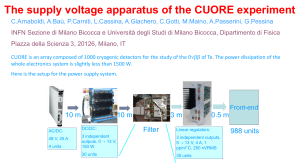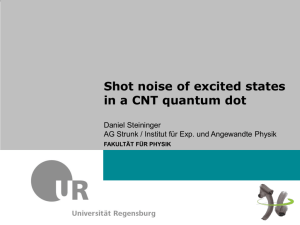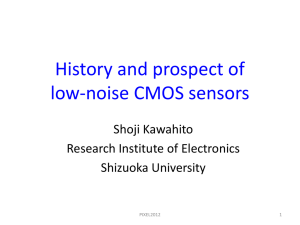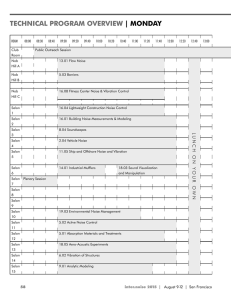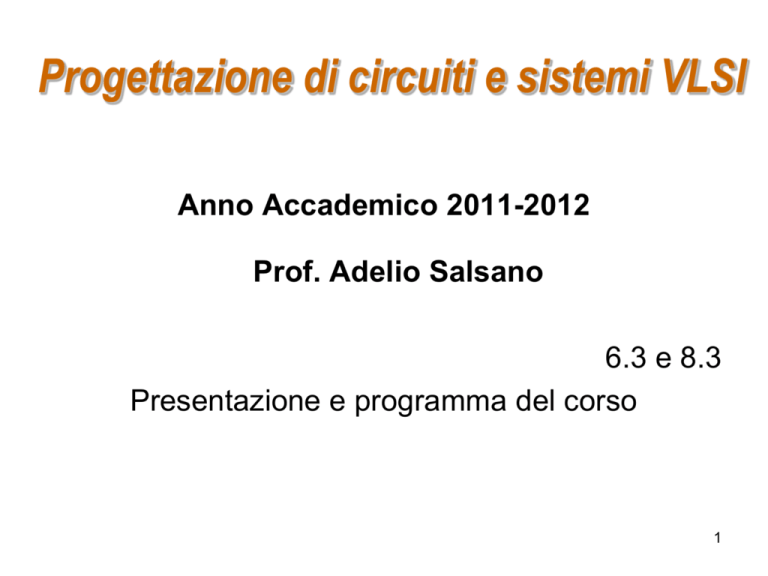
Progettazione di circuiti e sistemi VLSI
Anno Accademico 2011-2012
Prof. Adelio Salsano
6.3 e 8.3
Presentazione e programma del corso
1
Programma
• Cenni storici. Problematiche progettuali: costi,
prestazioni, potenza.
• Tecnologie integrate CMOS: passi progettuali,
regole di layout, packaging
• Richiami sui componenti elementari ideali e
reali. Modelli SPICE del diodo, del transistor
MOS e dei componenti passivi
• Interconnessioni, modelli RC. Modelli SPICE
delle connessioni
• Nanotecnologie: aspetti tecnologici e modelli
2
Programma (segue)
• Circuiti digitali elementari: inverter CMOS e
transmission gate. Caratteristiche statiche e
dinamiche. Potenza, energia e ritardo dei circuiti
elementari
• Porte logiche combinatorie. Logica statica e
dinamica. Prestazioni e caratteristiche
• Circuiti logici sequenziali. Latch e registri.
Pipeline
• Circuiti e sistemi digitali complessi e
metodologie di implementazione: processori,
PLA, FPGA, standard cell
• Memorie statiche e dinamiche. Memorie e non
volatili
3
Programma (segue)
• Affidabilità e tolleranza ai guasti dei circuiti
integrati. Circuiti integrati analogici: interruttori,
riferimenti di corrente e tensione, specchi di
corrente, amplificatori differenziali
• Strumenti per la progettazione di circuiti e
sistemi: linguaggi descrittivi, i principali
programmi di sintesi
• Progettazione custom, standard cell e
componenti programmabili
• Progettazione ad alta affidabilità e/o basso
consumo
4
Programma Esercitazioni (segue)
Sono previste esercitazioni sui seguenti temi:
• Programmi simulazione (LTSpice…)
• Calcolo parametri
• Progettazione digitale RTL
• Progetto circuiti e sistemi
• FPGA e Xilinx
• Linguaggi descrittivi
• Progettazione FPGA
5
Notizie sul corso
Esercitazioni
• Sono previste 25 ore di esercitazioni con l’uso di software di progetto
e simulazione di componenti e circuiti prevalentemente digitali.
Collaboratori
• Prof. Stefano Bertazzoni; Salvatore Pontarelli e Marco Ottavi
Materiale didattico
Jan M. Rabaey, Anantha Chandrakasan, Borivoje Nikolic, “Circuiti
Integrati Digitali: l’ottica del progettista”, Pearson Prentice Hall
R. L. Geiger, P.E. Allen, N.R. Strader VLSI design techniques for
analog and digital Circuits, Mac Graw Hill Int. Ed.
Diapositive lezione e esercitazioni
6
Notizie sul corso (segue)
ORARIO
Martedì 9,30 – 11,15 Aula C8
Giovedì 9.30 – 11.15 Aula C8
Venerdì 9.30 - 11.15 Aula C1
RICEVIMENTO STUDENTI
Lunedì e giovedì 15 – 16.30
7
What is this course/book about?
• Introduction to digital integrated circuits.
– CMOS devices and manufacturing technology.
CMOS inverters and gates. Propagation delay,
noise margins, and power dissipation. Sequential
circuits. Arithmetic, interconnect, and memories.
Programmable logic arrays. Design
methodologies.
• What will you learn?
– Understanding, designing, and optimizing digital
circuits with respect to different quality metrics:
cost, speed, power dissipation, and reliability
8
The First Computer
The Babbage
Difference Engine
(1832)
25,000 parts
cost: £17,470
9
ENIAC - The first electronic computer
(1946)
10
The Transistor Revolution
First transistor
Bell Labs, 1948
11
The First Integrated Circuits
Bipolar logic
1960’s
ECL 3-input Gate
Motorola 1966
12
Intel 4004 Micro-Processor
1971
1000 transistors
1 MHz operation
13
Intel Pentium (IV) microprocessor
14
Moore’s Law
He
made a prediction that semiconductor
technology will double its effectiveness every 18
months
In 1965, Gordon Moore noted that the number of
transistors on a chip doubled every 18 to 24
months.
15
1959
1960
1961
1962
1963
1964
1965
1966
1967
1968
1969
1970
1971
1972
1973
1974
1975
LOG2 OF THE NUMBER OF
COMPONENTS PER INTEGRATED FUNCTION
Moore’s Law
16
15
14
13
12
11
10
9
8
7
6
5
4
3
2
1
0
Electronics, April 19, 1965.
16
Evolution in Complexity
17
Transistor Counts
1 Billion
Transistors
K
1,000,000
100,000
10,000
1,000
i486
i386
80286
100
10
Pentium® III
Pentium® II
Pentium® Pro
Pentium®
8086
Source: Intel
1
1975 1980 1985 1990 1995 2000 2005 2010
Projected
Courtesy, Intel
18
Moore’s law in Microprocessors
Transistors (MT)
1000
2X growth in 1.96 years!
100
10
486
1
386
286
0.1
0.01
P6
Pentium® proc
8086
8080
8008
4004
8085
0.001
1970
1980
Year
1990
2000
2010
Transistors on Lead Microprocessors double every 2 years
Courtesy, Intel
19
Die Size Growth
Die size (mm)
100
10
8080
8008
4004
1
1970
8086
8085
1980
286
386
P6
Pentium
® proc
486
~7% growth per year
~2X growth in 10 years
1990
Year
2000
2010
Die size grows by 14% to satisfy Moore’s Law
Courtesy, Intel
20
Frequency
Frequency (Mhz)
10000
Doubles every
2 years
1000
100
486
10
8085
1
0.1
1970
8086 286
P6
Pentium ® proc
386
8080
8008
4004
1980
1990
Year
2000
2010
Lead Microprocessors frequency doubles every 2 years
Courtesy, Intel
21
Power Dissipation
Power (Watts)
100
P6
Pentium ® proc
10
8086 286
1
8008
4004
486
386
8085
8080
0.1
1971
1974
1978
1985
1992
2000
Year
Lead Microprocessors power continues to increase
Courtesy, Intel
22
Power will be a major problem
100000
18KW
5KW
1.5KW
500W
Power (Watts)
10000
1000
100
Pentium® proc
286 486
8086
10
386
8085
8080
8008
1 4004
0.1
1971 1974 1978 1985 1992 2000 2004 2008
Year
Power delivery and dissipation will be prohibitive
Courtesy, Intel
23
Power density
Power Density (W/cm2)
10000
1000
100
Rocket
Nozzle
Nuclear
Reactor
8086
10 4004
Hot Plate
P6
8008 8085
Pentium® proc
386
286
486
8080
1
1970
1980
1990
2000
2010
Year
Power density too high to keep junctions at low temp
Courtesy, Intel
24
Not Only Microprocessors
Cell
Phone
Small
Signal RF
Digital Cellular Market
(Phones Shipped)
Power
RF
Power
Management
1996 1997 1998 1999 2000
Units
48M 86M 162M 260M 435M
Analog
Baseband
Digital Baseband
(DSP + MCU)
(data from Texas Instruments)
25
Challenges in Digital Design
“Macroscopic Issues”
“Microscopic Problems”
• Time-to-Market
• Millions of Gates
• High-Level Abstractions
• Reuse & IP: Portability
• Predictability
• etc.
• Ultra-high speed design
• Interconnect
• Noise, Crosstalk
• Reliability, Manufacturability
• Power Dissipation
• Clock distribution.
Everything Looks a Little Different
?
…and There’s a Lot of Them!
26
10,000
10,000,000
100,000
100,000,000
Logic Tr./Chip
Tr./Staff Month.
1,000
1,000,000
10,000
10,000,000
100
100,000
Productivity
(K) Trans./Staff - Mo.
Complexity
Logic Transistor per Chip (M)
Productivity Trends
1,000
1,000,000
58%/Yr. compounded
Complexity growth rate
10
10,000
100
100,000
1,0001
10
10,000
x
0.1
100
xx
0.01
10
xx
x
1
1,000
21%/Yr. compound
Productivity growth rate
x
x
0.1
100
0.01
10
2009
2007
2005
2003
2001
1999
1997
1995
1993
1991
1989
1987
1985
1983
1981
0.001
1
Source: Sematech
Complexity outpaces design productivity
Courtesy, ITRS Roadmap
27
Why Scaling?
• Technology shrinks by 0.7/generation
• With every generation can integrate 2x more
functions per chip; chip cost does not increase
significantly
• Cost of a function decreases by 2x
• But …
– How to design chips with more and more functions?
– Design engineering population does not double every
two years…
• Hence, a need for more efficient design methods
– Exploit different levels of abstraction
28
Design Abstraction Levels
SYSTEM
MODULE
+
GATE
CIRCUIT
DEVICE
G
S
n+
D
n+
29
Design Metrics
• How to evaluate performance of a
digital circuit (gate, block, …)?
– Cost
– Reliability
– Scalability
– Speed (delay, operating frequency)
– Power dissipation
– Energy to perform a function
30
Cost of Integrated Circuits
• NRE (non-recurrent engineering) costs
– design time and effort, mask generation
– one-time cost factor
• Recurrent costs
– silicon processing, packaging, test
– proportional to volume
– proportional to chip area
31
NRE Cost is Increasing
32
Die Cost
Single die
Wafer
Going up to 12” (30cm)
From http://www.amd.com
33
Cost per Transistor
cost:
¢-per-transistor
1
0.1
Fabrication capital cost per transistor (Moore’s law)
0.01
0.001
0.0001
0.00001
0.000001
0.0000001
1982
1985
1988
1991
1994
1997
2000
2003
2006
2009
2012
34
Yield
No. of good chips per wafer
Y
100%
Total number of chips per wafer
Wafer cost
Die cost
Dies per wafer Die yield
wafer diameter/2 2 wafer diameter
Dies per wafer
die area
2 die area
35
Defects
defects per unit area die area
die yield 1
is approximately 3
die cost f (die area) 4
36
Some Examples (1994)
Chip
Metal Line
layers width
Wafer
cost
Def./ Area Dies/ Yield
cm2 mm2 wafer
Die
cost
386DX
2
0.90
$900
1.0
43
360
71%
$4
486 DX2
3
0.80
$1200
1.0
81
181
54%
$12
Power PC
601
4
0.80
$1700
1.3
121
115
28%
$53
HP PA 7100
3
0.80
$1300
1.0
196
66
27%
$73
DEC Alpha
3
0.70
$1500
1.2
234
53
19%
$149
Super Sparc
3
0.70
$1700
1.6
256
48
13%
$272
Pentium
3
0.80
$1500
1.5
296
40
9%
$417
37
Reliability―
Noise in Digital Integrated Circuits
v(t)
V DD
i(t)
Inductive coupling
Capacitive coupling
Power and ground
noise
38
DC Operation
Voltage Transfer Characteristic
V(y)
V
VOH = f(VIL)
VOL = f(VIH)
VM = f(V(X)
f
OH
V(y)=V(x)
per V(x) = V(y)
VM Switching Threshold
V OL
V IL
V
IH
V(x)
Nominal Voltage Levels
39
Mapping between analog and digital signals
V
“ 1”
V
OH
V
V
IH
out
Slope = -1
OH
Undefined
Region
V
“ 0”
V
Slope = -1
IL
V
OL
OL
V
IL
V
IH
V
in
40
Definition of Noise Margins
"1"
V
OH
Noise margin high
NM H
V
IH
Undefined
Region
V
OL
NM L
V
IL
Noise margin low
"0"
Gate Output
Gate Input
41
Noise Budget
Allocates gross noise margin to expected sources
of noise
Sources: supply noise, cross talk, interference,
offset
Differentiate between fixed and proportional noise
sources
42
Key Reliability Properties
• Absolute noise margin values are deceptive
– a floating node is more easily disturbed than a node driven by a
low impedance (in terms of voltage)
• Noise immunity is the more important metric – the
capability to suppress noise sources
• Key metrics: Noise transfer functions, Output impedance of the
driver and input impedance of the receiver;
43
Regenerative Property
Regenerative
Non-Regenerative
44
Regenerative Property
v0
v1
v2
v3
v4
v5
v6
A chain of inverters
Simulated response
45
Fan-in and Fan-out
N
Fan-out N
M
Fan-in M
46
The Ideal Gate
V out
Ri =
Ro = 0
Fanout =
NMH = NML = VDD/2
g=
V in
47
An Old-time Inverter
5.0
4.0
NM L
3.0
2.0
VM
NM H
1.0
0.0
1.0
2.0
V
3.0
in (V)
4.0
5.0
48
Delay Definitions
49
Ring Oscillator
T = 2 tp N
50
A First-Order RC Network
R
vin
vout
C
tp = ln (2) t = 0.69 RC
Important model – matches delay of inverter
51
Power Dissipation
Instantaneous power:
p(t) = v(t)i(t) = Vsupplyi(t)
Peak power:
Ppeak = Vsupplyipeak
Average power:
Vsupply t T
1 t T
Pave
p(t )dt
isupply t dt
t
T t
T
52
Energy and Energy-Delay
Power-Delay Product (PDP) =
E = Energy per operation = Pav tp
Energy-Delay Product (EDP) =
quality metric of gate = E tp
53
A First-Order RC Network
Vdd
E0->1 = C LVdd2
R PMOS
A1
i
vout supply
NETWORK
vAinN
NMOS
CVLout
CL
NETWORK
T
E
01
= P t dt = V i
t dt = V
dd sup ply
dd
0
0
T
E
Vdd
T
T
= P
t dt = V
i
t dt =
ca p
cap
out ca p
0
0
0
C dV
= C V 2
L out
L
dd
Vdd
1
2
-C V
C L Vout dVout = -dd
2 L
0
54
Summary
Digital integrated circuits have come a long way and still
have quite some potential left for the coming decades
Some interesting challenges ahead
Getting a clear perspective on the challenges and
potential solutions is the purpose of this book
Understanding the design metrics that govern digital
design is crucial
Cost, reliability, speed, power and energy dissipation
55

